Camp Lingo: A Mini Falling Creek Dictionary
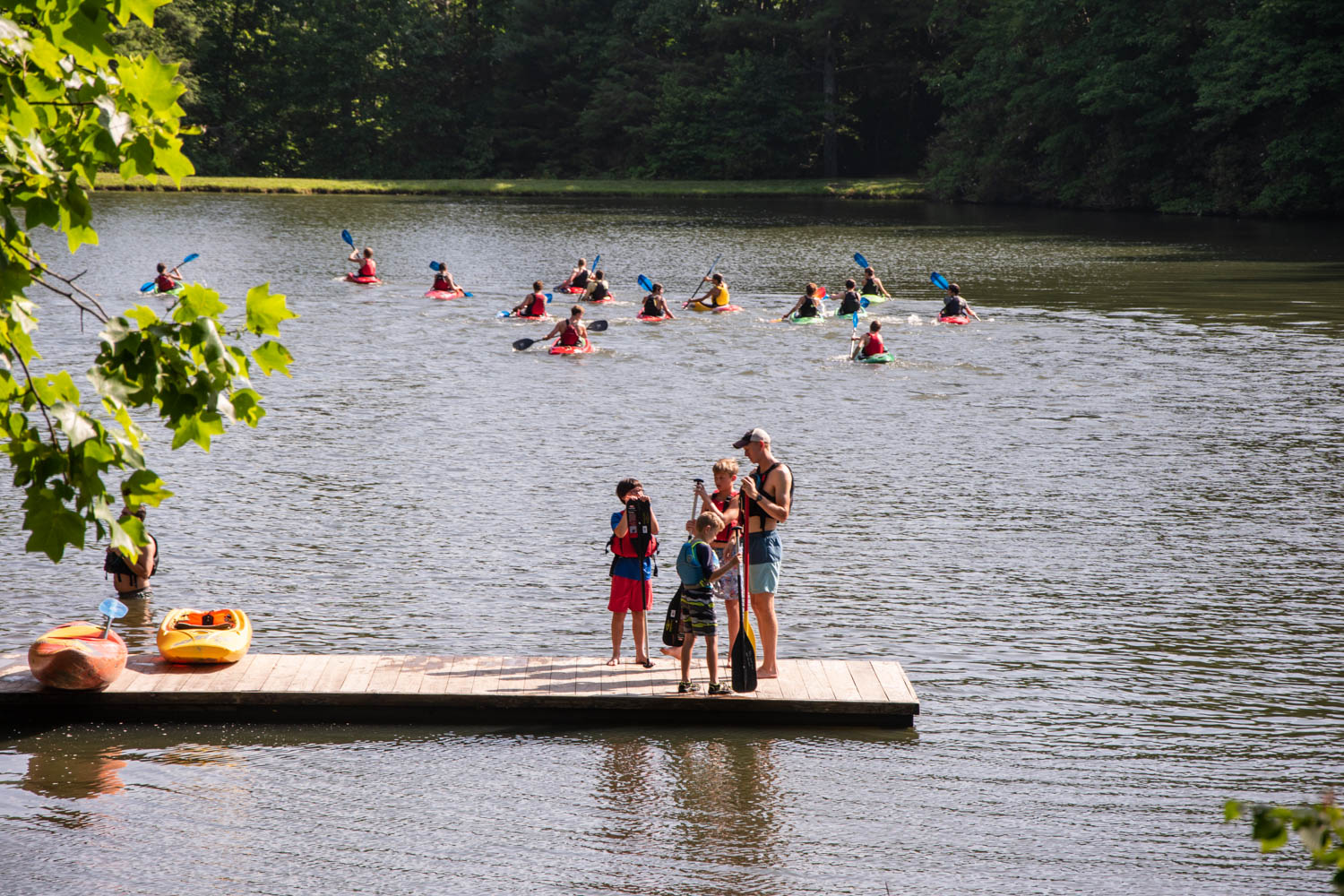 The Yak Shak is always a popular place! But what/where is the Yak Shak?
The Yak Shak is always a popular place! But what/where is the Yak Shak?
For many campers, staff, and alumni, Falling Creek feels like a second home - and like any close community, there are funny words and phrases unique to camp that have been created over the years! After a while, the weird phrases and “lingo” seem to fit seamlessly into camp vocabulary, but this camp lingo can be confusing to anyone who has never been to Falling Creek before. Everyone was a first-time camper or counselor once, so we asked our campers and staff to imagine back to the first day at camp, when everything was new and unknown, and tell us the camp lingo that confused them at first!
Today, we’re using their answers and writing all about the weird camp words and phrases you might hear if it’s your first time at camp. Hopefully this mini dictionary will help you feel more comfortable and in-the-know when you arrive at Falling Creek! If you still have questions though, don’t worry - returning staff and campers will always happily explain what camp words mean. Camp lingo is fun because it’s ever-evolving!
Places Around Camp:
Yak Shack: Think yak as in “kayak”. This is the building on the lower lake where our paddling program is based. Also on the lower lake is the “Gates Course”, which is a series of hanging poles that paddlers navigate through like slaloms, in order to build their paddling skills before a trip.
Goody Shack: Located on the ball field, this covered pavilion is named after Jim “Goody” Goodrum. Goody was a camper from 1980-87, a CIT 1988-89, and on staff 1990-2002, before returning from 2008-17 as an associate program director and staffing director. He now works at nearby Christ School as Dean of Student Engagement, head of Summer Programs, and head coach of the middle school basketball team. The Goody Shack is used as a meeting place for things like Cross Country, early morning Bible studies, and hanging out during free time.
 The Thunder Dungeon lets us keep playing soccer, no matter if it’s blazing hot or pouring rain outside!
The Thunder Dungeon lets us keep playing soccer, no matter if it’s blazing hot or pouring rain outside!
Thunder Dungeon: This is the indoor soccer field located under the basketball courts in the McGrady Family Gym (named for Chuck and Jean McGrady, the owners and directors from 1989-2005). The “Thunder Dungeon” got its name from the thunderous sound of soccer balls and dodgeballs hitting the walls during games.
Shangri La: This is one of the most well-known cabin overnight spots at camp, located off the ridge near the Green River pastures. It’s the site of an old cabin that was lived in before camp existed, and though the building itself is long gone, the fireplace and chimney still remain, making it a really cool spot to make s’mores. Unfortunately, this place sometimes gets a bad rap because counselors over the years have made up ghost stories there, but none of them are true. Located next to a scenic creek, it’s one of the best cabin overnight sites on property.
“Under the Dining Hall”: This sometimes feels like the hub of camp, and is a great place to hang out during free time, or to meet after announcements to sign up for trips. Under the Dining Hall is open-air, and looks out over the upper lake. There are foosball and ping pong tables here, as well as the Program Office and the Camp Store. As you walk from Morning Watch to the Dining Hall, you’ll pass “backwards bridge” and go up “sideways stairs,” since everyone walks backwards and sideways across these spots on their way to breakfast.
Bain Bridge: This is the bridge to the Campfire Area, named for Donnie and Kim Bain. When you cross the bridge and enter the Campfire Area, you take off your hat and become silent until you exit the Campfire Area at the end of the night. This is an important tradition for many, and the bridge is symbolic of this special place at camp for staff and campers alike. Donnie was a Camp Director with Chuck for decades, and his wife Kim ran the Program Office. The Bain Bridge was dedicated in their honor during our 50th anniversary reunion weekend in 2018.
 Camp Chaplain and Mountaineering Instructor, Dusty Davis, leading a group from the Campfire area across Bain Bridge, dedicated to Donnie and Kim Bain in 2018
Camp Chaplain and Mountaineering Instructor, Dusty Davis, leading a group from the Campfire area across Bain Bridge, dedicated to Donnie and Kim Bain in 2018
Blob: This is like a giant balloon, floating on the upper lake. One person jumps off the diving board onto the Blob and scoots to the end. When the next person jumps on, it sends the first person rocketing off into the water!
Roller Coaster: Like the Blob, this is another fun element at the waterfront. Boys sit on a board with wheels and slide down the ramp into the water, either solo or with a friend (counselors can join too!). The base of the “roller coaster” is located at the waterfront side of the upper lake, and the start is at the corner of the ball field. It’s a blast!
Moab: This is the building where our mountain biking program is located, on the main road between the overlook gazebo and the barn. Moab was named for Moab, Utah, a world-famous mountain biking mecca. However, in the decades since our “Moab” has been named, the area surrounding camp has also become pretty well-known for great riding and trails!
Moho: Across the road from Moab is Moho, a nickname for “mountaineering hut.” This is where all our backpacking and climbing gear lives. You can also admire the many plaques decorating the walls outside, commemorating the exciting backpacking and climbing trips over the years.
A-Frame: This is the building where the camp doctor and his family live, and is located near the tennis courts, above the pickleball courts. It’s named after the “A” shape made by the steep sides of the roof.
Iolaire: This is the name for the house that Yates, Marisa, and their daughters live in. It is located up past the barn by the pastures.
Upper Lake vs. Lower Lake vs. Lake Summit: We have two lakes at camp, plus another that we visit daily for our Sailing program. At camp, the Upper Lake is the one we use for swimming, and the Lower Lake is for paddling lessons. You can fish in either lake, just not right next to the swim docks. Neither of the lakes at camp are big enough for sailboats, so twice a day every day, we take trips to our private dock on Lake Summit. It’s only a 10 minute van drive to Lake Summit.
The Roost: This the staff lounge, where counselors can go during their time-off to relax and hang out. (Some say it’s located under the Upper Lake, and guarded by “Beaver Sharks”, though that claim has yet to be validated!)
Upper Amphitheater: Also called “I Do View” becuase of the several weddings held in this location, this is a terraced outdoor amphitheater, with arguably the best view in camp. It is located at the top of the upper horse pasture, between the barn and Iolaire, and looks out on the Green River Valley.
Top of the World: Another great view spot, this is a field on the old apple orchard side of camp. It overlooks Coyote Mountain and has some fun hiking and biking trails leading to it from multiple sides. Sometimes we gather here in small groups on Line Campfire evenings.
 Enjoying s’mores with a view at the Upper Amphitheater.
Enjoying s’mores with a view at the Upper Amphitheater.
Games at Camp:
Taco Cat: this is a made-up game on the ball field that you’ll probably play during Evening Program after dinner. It’s similar to capture-the-flag, but with frisbees and more fun!
Multi Ball: another popular Evening Program game, usually taking place at the tennis courts. Similar to dodgeball, but with no teams, and everyone is trying to tag each other with the balls. However, once you pick up a ball, you cannot take more than three steps before throwing it, and you have to throw underhand. Once you are tagged you sit down where you are, but you can stand back up if the person who got you out gets tagged.
Wild Wild West: this is an example of a game we would play as a whole camp community on a Saturday. Rather than being limited to the ball field, all-camp-games take place all over the property, where teams can hide, run, and strategize using the trails, roads, and fields around camp boundaries. In Wild Wild West, campers are divided into 4 teams, and wear flags that can be pulled by certain team colors. You can bring the flags you’ve collected to the “bank”, and also look for hidden gold around camp to get more points for your team.
Warrior Ball: Warrior Ball is an outdoor form of dodgeball played in an octagon-shaped arena that we call our ‘Warrior Ball Pit.’ The Warrior Ball Pit is right next to the Dining Hall, by the ping pong and foosball tables! You can play everyday if you like, and it’s a popular spot during Free-Times. The game is like ‘Ga-Ga Ball’ or ‘Pit Ball’. You can read all the rules on how to play here
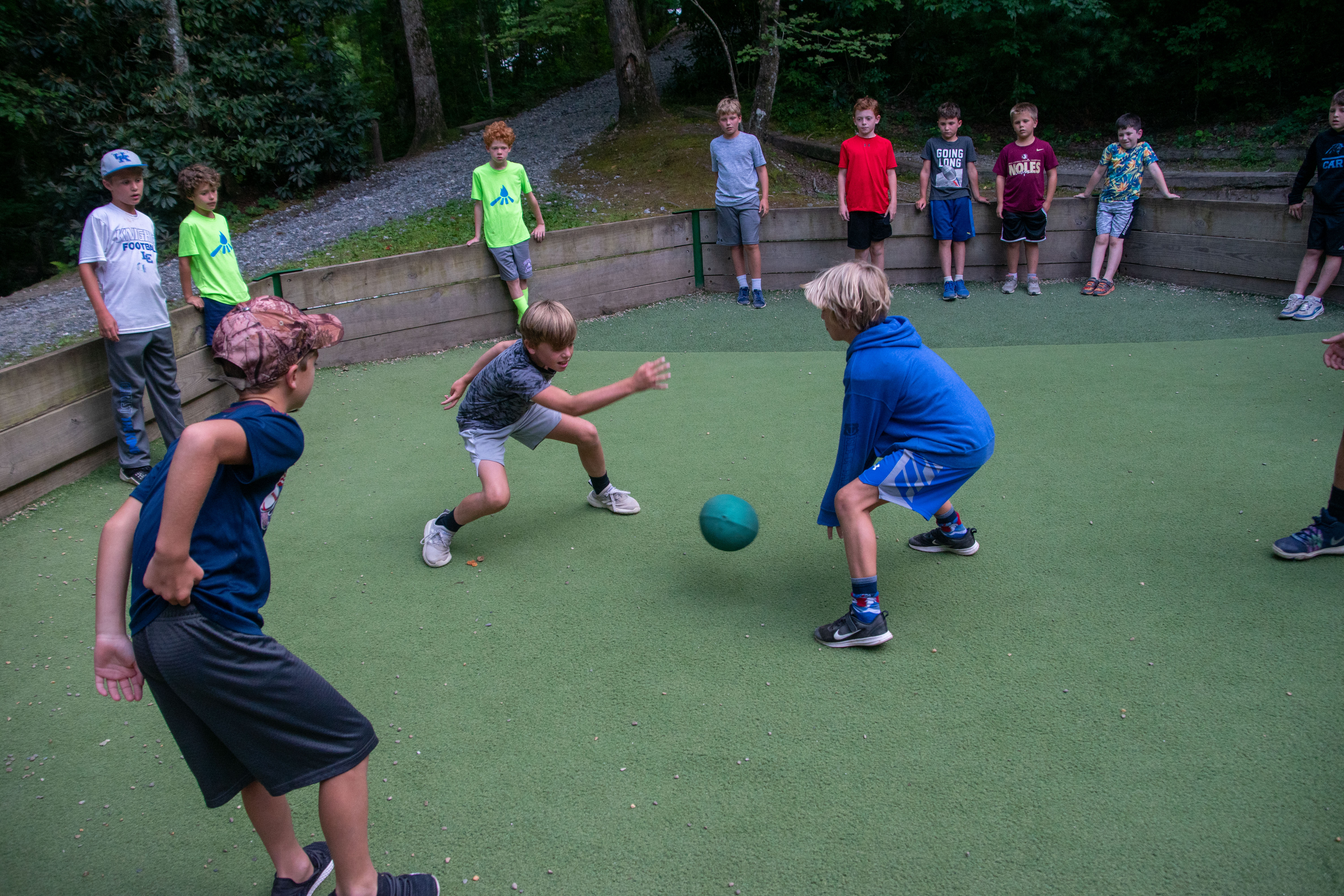 What is Warrior Ball?
What is Warrior Ball?
Times of the Day:
Morning Watch vs. Morning Assembly: Every morning after waking up and getting ready for the day, we gather at Morning Watch for a thought or message to start the day. Everyone is silent during Morning Watch, and we sit on benches by cabin, as a peaceful beginning to the day. Morning Assembly is after breakfast on the front porch, and it is anything but silent! This is the time where counselors perform hilarious skits, we sing songs, and daily announcements are made.
Push Up Porch: This is a tradition that has started after Morning Assembly is over, where anyone who would like to stay behind for a daily pushup challenge is welcome. Push Up Porch starts with one push up on the first day of camp, and increases by one push up each day.
Milk and Cookies: After Evening Program, we return to the Dining Hall each night for a light cookie and milk snack. It’s also a nice way to wind down after a high energy Evening Program game.
Evening Embers: After everyone gets ready for bed, this is how we end the day as a cabin. Everyone gathers around a candle and talks about their day, as well as a daily question to discuss as a group.
Taps: This is played at the end of the day when everyone is in bed, and comes from the military where a bugle was played as a “lights-out” signal to soldiers. After Campfire on Sundays, we also sing taps together. The words are: Day is done, gone the sun, from the lakes, from the hills, from the skies. All is well, safely rest, God is nigh.
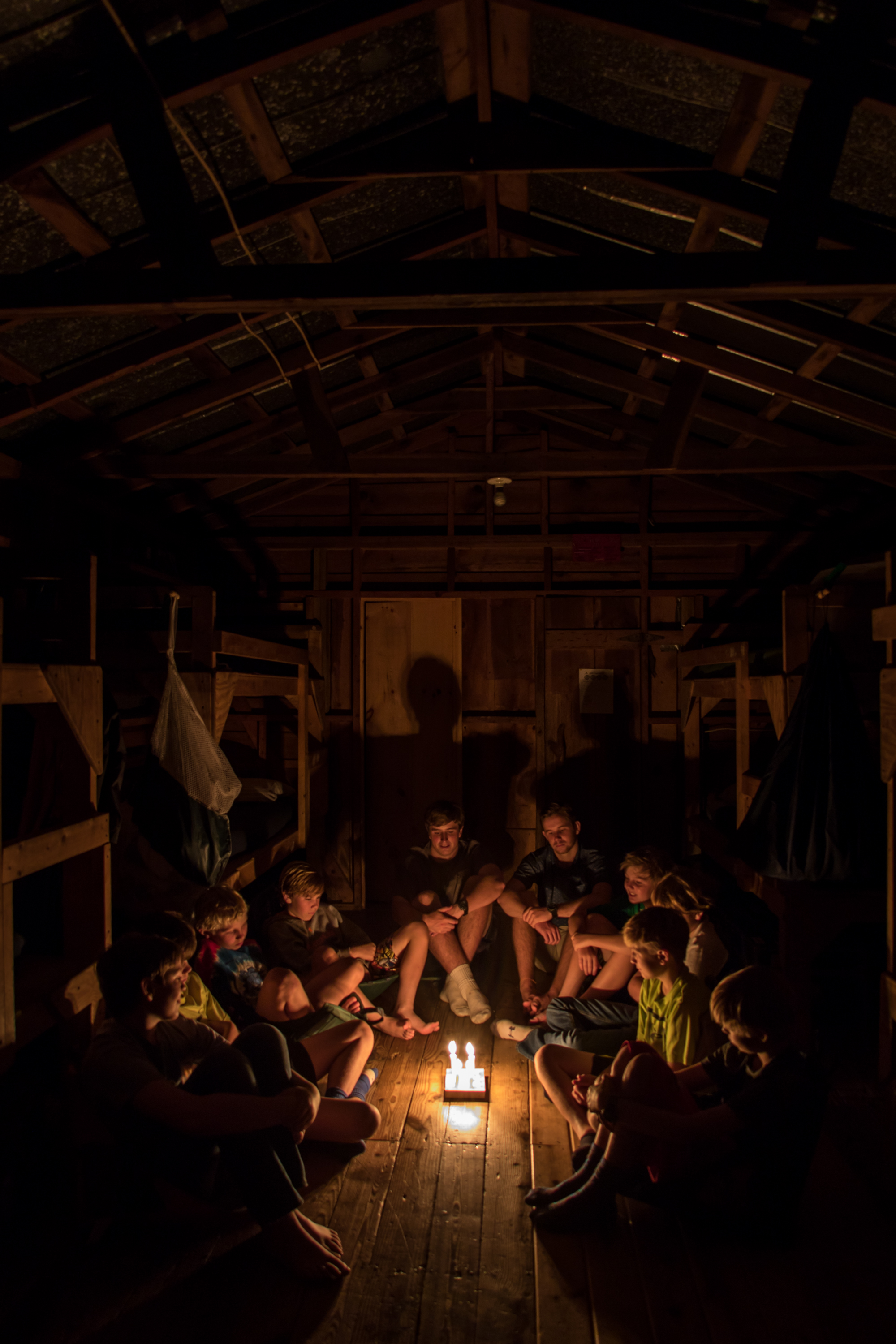 No better way to end the day than with Evening Embers as a cabin
No better way to end the day than with Evening Embers as a cabin
It Stands For What?
FLINT vs STEEL vs DASH: The names of our oldest camper leadership programs might seem confusing at first, but the words are actually acronyms, which means that the letters stand for other words. For FLINT, these are our campers who have completed 10th grade. Campers in this age group are still regular campers with the freedom to sign up for the activities or trips of their choice. FLINT stands for “Forging Leaders INTentionally.”
FLINT campers are eligible to apply to the STEEL program for the following summer, which was previously known as our Counselor-In-Training program, and is highly selective. STEEL stands for Summer Training Encouraging Emerging Leaders. The program is for former Falling Creek campers who have completed 11th grade. Components of these programs are intentionally designed to foster leadership, service, responsibility, and teamwork.
It is possible to return to camp in the summer after 12th grade. Our dining service team, known as DASH, works during the summer in the “dash” between Camper and Counselor. In this program, they have the opportunity to experience a different sort of work “behind-the-scenes” in the kitchen at camp while getting paid as a staff member.
FARM: The F.A.R.M. stands for Food, Animals, Repurposing, and Manpower, all of which boys learn about in this activity. They have the chance to plant and harvest vegetables from our 15 raised beds, grow herbs and flowers, and care for our dozens of chickens. At the F.A.R.M., boys gain a better understanding of their footprint, as well as the importance of their influence on the environment. Through the F.A.R.M., our goal is to strengthen the connection boys have with food and nature, as part of our Green Camp Initiative.
OSC: This is Outdoor Skills Certified, where boys learn outdoor skills and tips for surviving in the woods, as well as basic camp craft that they can use on overnights and trips. The activity location is in a beautiful clearing in the woods below the lower dam, right next to a peaceful creek. Boys can work on skills essential for any outdoorsman, including fire building, making rope from natural fibers, reading maps and navigating with a map and compass, identifying harmful or helpful plants, building outdoor shelters, and more.
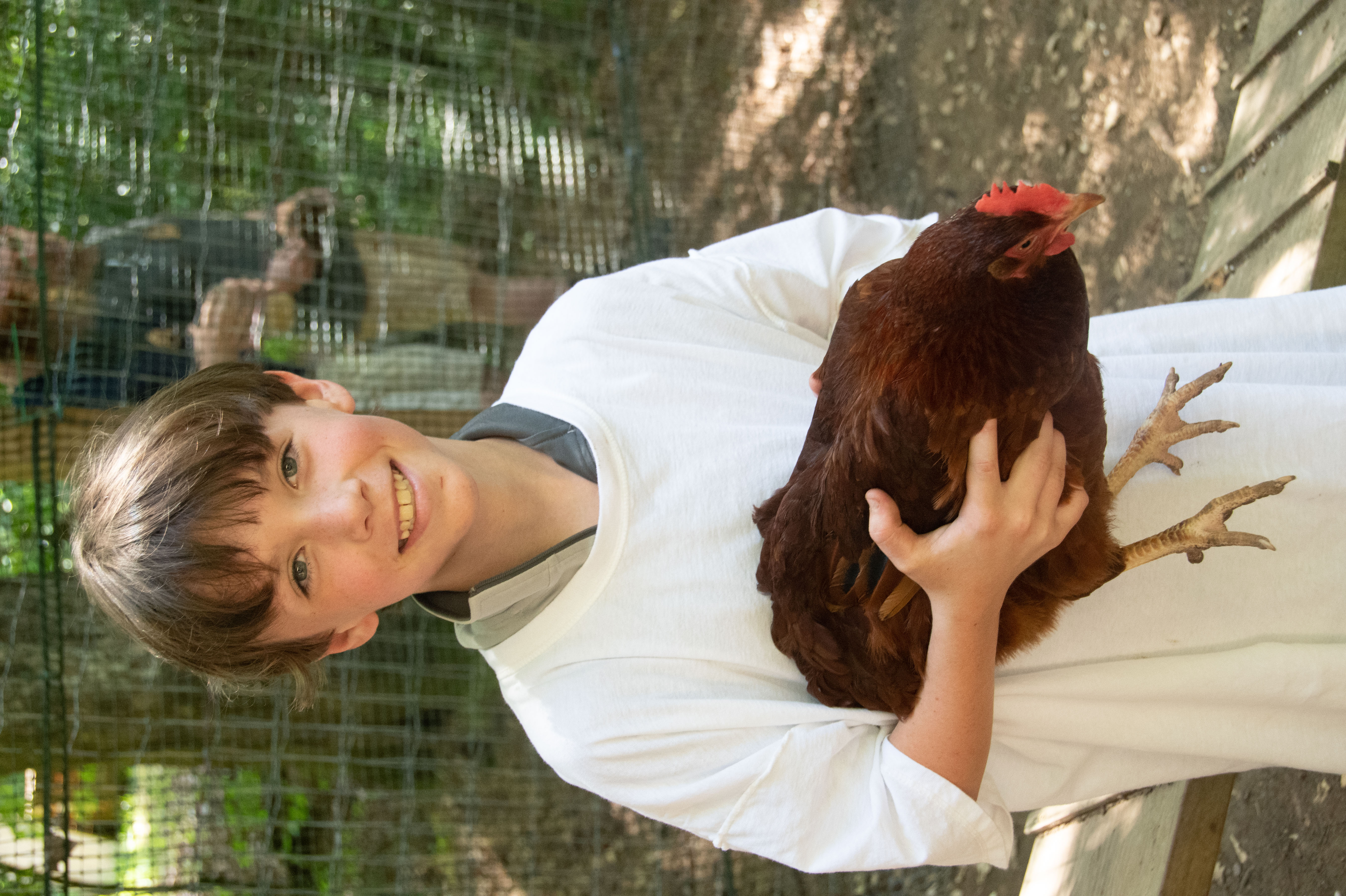 Hanging out with chickens is just one of the fun parts about the FARM!
Hanging out with chickens is just one of the fun parts about the FARM!
Camp Cheers:
Behold: You’ll hear this word a lot around camp. Sometimes it is spoken quietly as the formal opening to the start of our Campfires, or it is cheered loudly at the end of a group huddle. It comes from the beginning of Psalm 133:1, “Behold, how good and how pleasant it is for brothers to dwell together in unity.”
Shocktaw: This is the cheer used by the mountain bikers during their activity announcements, accompanied by the “S” hand sign. You make a “rock on” sign with your hands, and stack right over left so it looks like an “S”, for shocks on a mountain bike.
Slothclaw: This is the cheer used by the rock climbers, who shout “Slothclaw!” after announcements and hold up two fingers like a claw, ready to climb!
Coleslaw: This is a newer cheer, and used by those at the climbing wall to differentiate between climbing wall announcements and rock climbing trip announcements.
Pinkies Up: This is the cheer used by paddling, (along with the cheer “paddle hard!”, which has a pretty self explanatory message). The idea behind “pinkies up,” is that when you are comfortable kayaking down a river, you should be able to grip your paddle in a relaxed enough way that you can lift up your pinkies.
Take a Hike!: When backpacking staff yell this after their announcements, everyone shouts “ahhhhh” while spinning their finger in the air, and then “take a hike!” while motioning back with their thumb.
 Shocktaw!
Shocktaw!
Food:
Milk & Cookies: Most nights after Evening Program, you’ll return to the Dining Hall for milk and cookies before going to your cabin for the night! Nothing like a cold glass of milk and a warm sugar cookie to help you wind down before bedtime - not that you’ll need any help feeling sleepy after a big day at camp!
Pisgah Pizza: This recipe is a favorite on cabin overnights or trips out of camp. Just use a tortilla or pita as the base, cover it in cheese and pizza toppings, and cook it in a frying pan on the stove or over the fire.
Frito Pie: Ground beef, fritos, beans, and toppings all mixed together - Frito Pie is a meal so beloved, counselors even made up a song about it to the tune of the Star Spangled Banner. The only words in the song are “Frito Pie” repeated over and over, but someone is bound to stand on their chair and begin singing if it gets served.
Longenecker Lumps: This recipe is almost as legendary as it’s inventor, Steve Longenecker. Steve has been a long time outdoor educator, nature enthusiast, falconer, rock climber, and “lump chef” at Falling Creek since 1975. (bonus camp lingo word: the camp library is named Esefel, after Steve, known by many as SFL). Steve shared that his “lump recipe” was born during a backpacking trip in the 60s: “I was on a hiking trip with some boys and we were camping in the Shining Rock area. We had some leftover bacon grease in a small metal can and some left-over biscuit mix. I heated up the grease, dropped in a glob of dough and ‘Longenecker Lumps’ were born!” Steve brought the recipe from his time at Camp Mondamin, to Camp Sequoyah, and finally to us at Falling Creek, where boys can sign up to cook these treats during camp sessions. You can check out the recipe for Longenecker Lumps and other trip favorites here!
 Cooking Longenecker Lumps on the porch of Esefel (the library named after Steve Longenecker/SFL)
Cooking Longenecker Lumps on the porch of Esefel (the library named after Steve Longenecker/SFL)
Progressions:
Waypoints: In navigation, waypoints are a set of coordinates that represent a fixed location, or an objective along a planned course in one’s journey. Falling Creek developed the Waypoints tradition so campers and staff can pursue intentional objectives throughout their camp journey. Progression is not age-restricted, as the boys are able and encouraged to pursue advancement based on their interest. There are Waypoints for each individual’s unique course at Falling Creek, from campers to staff members. Currently, 5 levels of progression Waypoints can be earned in nearly 50 activities and specialty awards. Achievements will be rewarded with Waypoint Markers at the end of each session that can be proudly displayed on a frame-worthy base map of Falling Creek’s campus. Each camper or staff member receives this map during their first year at camp.
“Getting your Warrior”: In the Progression waypoints, there are five levels for each activity. Scout, Explorer, Challenger, Ranger, and Warrior. When you earn your Warrior, you have earned the highest level in that activity, and you get recognized with an announcement at mealtime.
Journeyman: A Journeyman is a camper who has attained Warrior, the highest level of a program, in at least three different activities and consistently demonstrates that he lives by the FCC Code. Journeymen are eligible to take part in a “Journey” at the end of the Main Camp session. Once a camper is designated as a Journeymen, he is presented to the camp community at Campfire, and chooses a staff member to be his mentor, helping him prepare for the Journey. If they successfully complete this Journey, they earn the rank of Keeper of the Flame, the highest rank attainable at Falling Creek. The Journey consists of several unique parts, combining skills and drawing from experiences that campers earn during their time at Falling Creek. This includes building and tending a campfire; venturing out on an overnight solo experience; composing an essay about one’s time at Falling Creek, detailing how to share your light with others; cutting and splitting wood to be used at future Sunday night campfires; and completing an orienteering challenge.
Keeper of the Flame: If Journeymen successfully complete the Journey as described above, they earn the rank of Keeper of the Flame, the highest rank attainable at Falling Creek. All Keepers were once Journeymen, but not all Journeymen make it to become a Keeper of the Flame. If a boy is unable to fully complete the requirements of the Journey, he remains a Journeyman and is eligible to try again in a future summer.
 Journeymen helping chop wood for future Campfires during their Journey.
Journeymen helping chop wood for future Campfires during their Journey.
Other Camp Lingo:
Honor Council: If you go to the Lodge, you’ll see the walls covered with signs and banners from years past, each with a quote about something related to camp. Some are about friendship, unselfishness, kindness, spreading light, or other similar themes. Each is made by the Honor Council from that year. The Honor Council are campers elected by the entire camp community during Main Camp. Those elected are boys whose peers believe they strongly exemplify the Falling Creek Spirit and Code, and are tapped and recognized during Campfire. There are representatives from all four tribes, so all ages participate. The size of the group ranges from 15-25. The group meets with directors and staff who were on Honor Council when they were campers, at least once a week to discuss how they feel camp is operating. The group elects a leader to serve as a point person to communicate with the directors. Meetings are run using Robert’s Rules of Order and they divide up the “positive” and “challenges” feedback with various members of the council who share these with the entire staff Sunday evening at the beginning of the weekly staff meeting. Councilmembers learn the difference between constructive vs. critical feedback through these meetings, and are tasked with the responsibility of being good role models and voices for their peers.
Chuck Norris: This is the software that we created to allow maximum freedom-of-choice for our campers, while still ensuring safety at all times. “Chuck Norris” is what we call this software, which is accessed by counselors only through a tablet at each activity. Counselors and medical staff use the software when they take attendance, monitor activity progressions, keep track of their campers’ medication for trip preparation, know when boys are out on trips, and more. Giving counselors a way to store and immediately reach this important information allows us to give boys more freedom in choosing activities, going on trips, and moving around camp independently.
Perry Weather: This is an automated lightning prediction system that sits on the top of our Dining Hall, and gives a warning siren if there is risk of lightning striking close nearby. If you hear a loud siren, this is what it indicates:
- One Long Blast – Lightning is predicted in the immediate area. You may go to activities and use the trails at camp, but please stay out of the water and open areas such as the field, parking lots, and courts.
- Three Short Blasts – All clear signal. This means the threat of a lightning strike has passed.This device allows us to play and swim safely, sensing and notifying us if there is risk of lightning, so we have plenty of time to get out of the water and off the ridge. We go over this during the first day of camp, so you will know what the siren sounds like, and what it sounds like when it gives the “all-clear” signal.
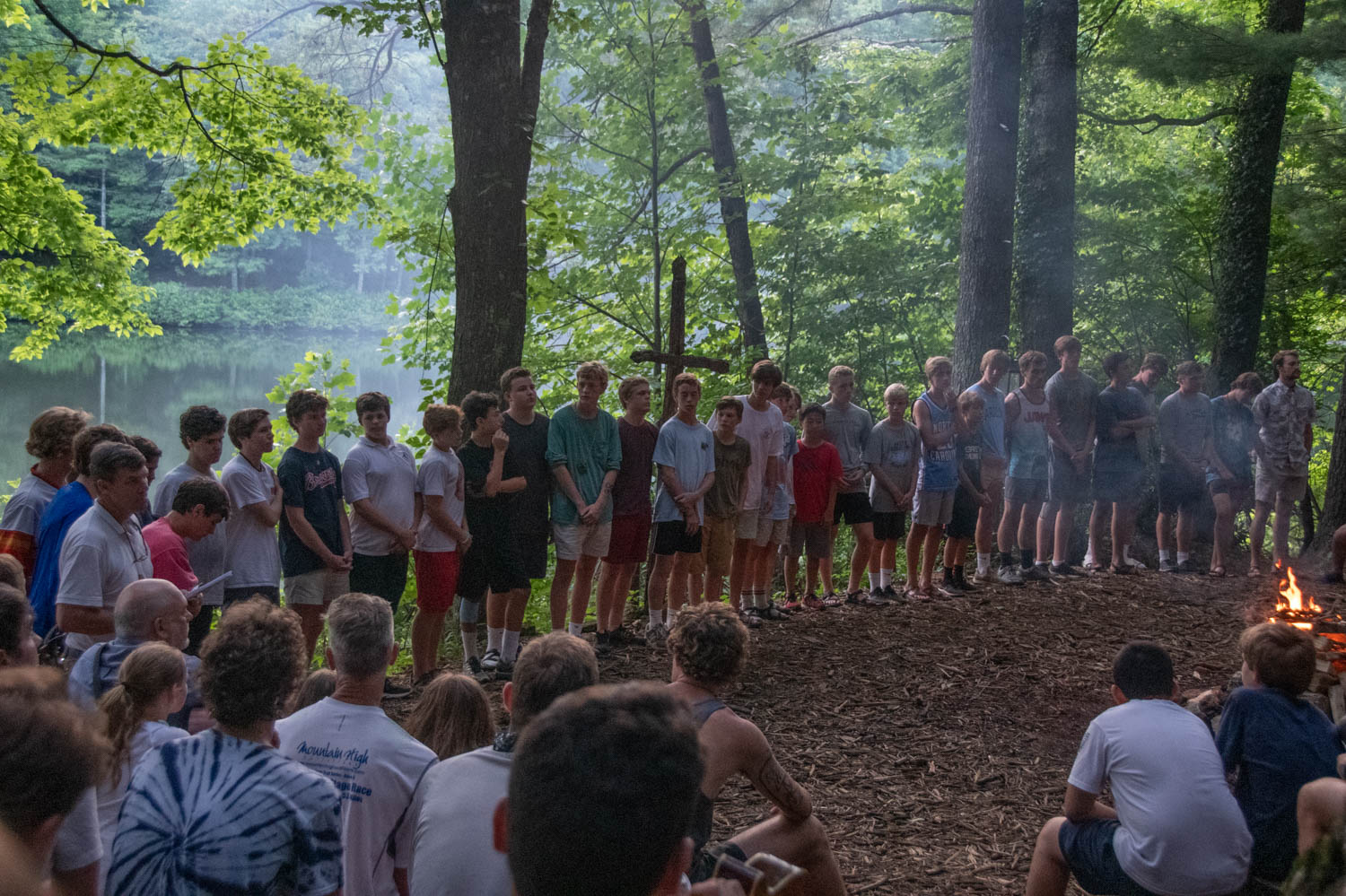 Honor Council getting tapped at Campfire
Honor Council getting tapped at Campfire
What did we miss? Email annie@fallingcreek.com with more words you want to see added to this mini Falling Creek dictionary!